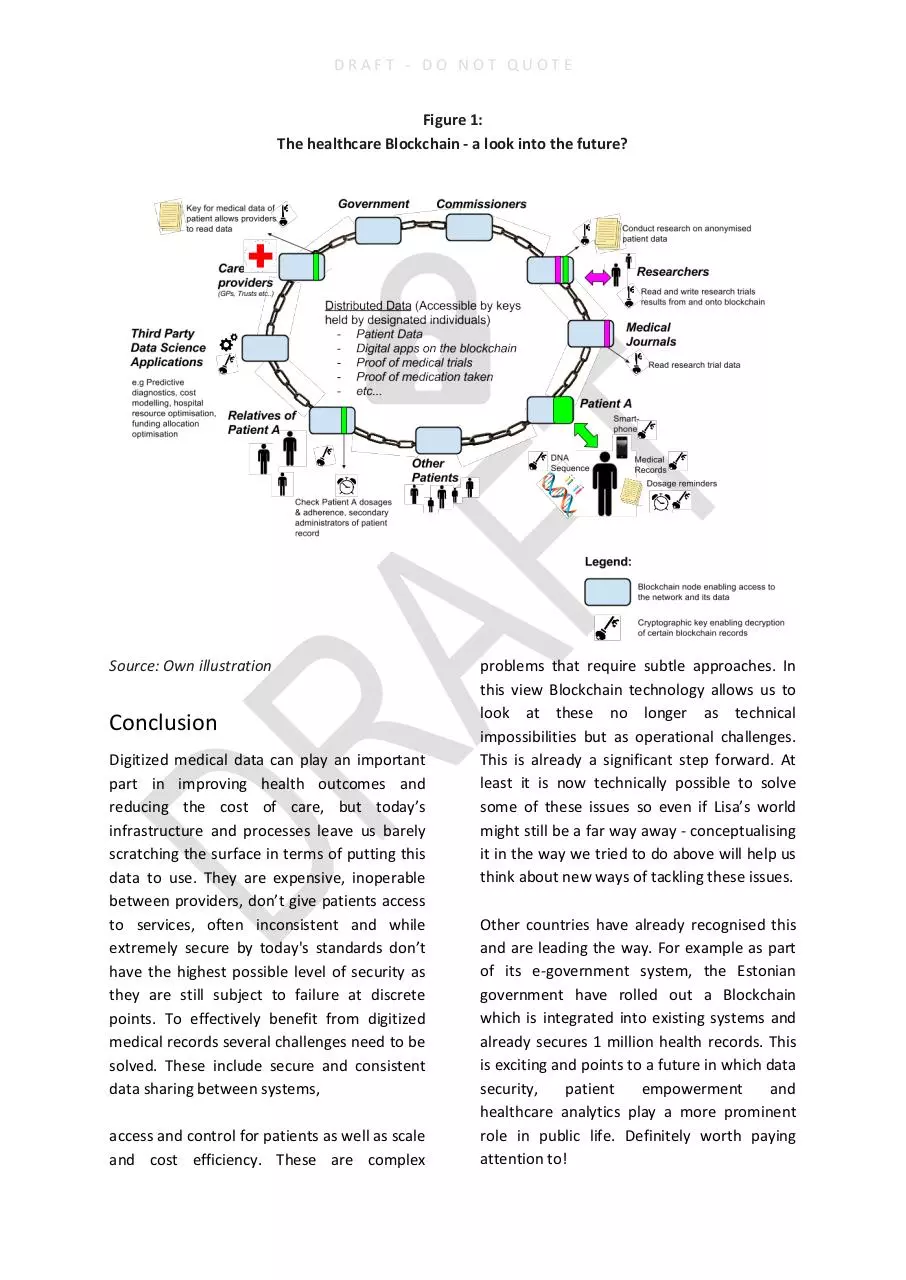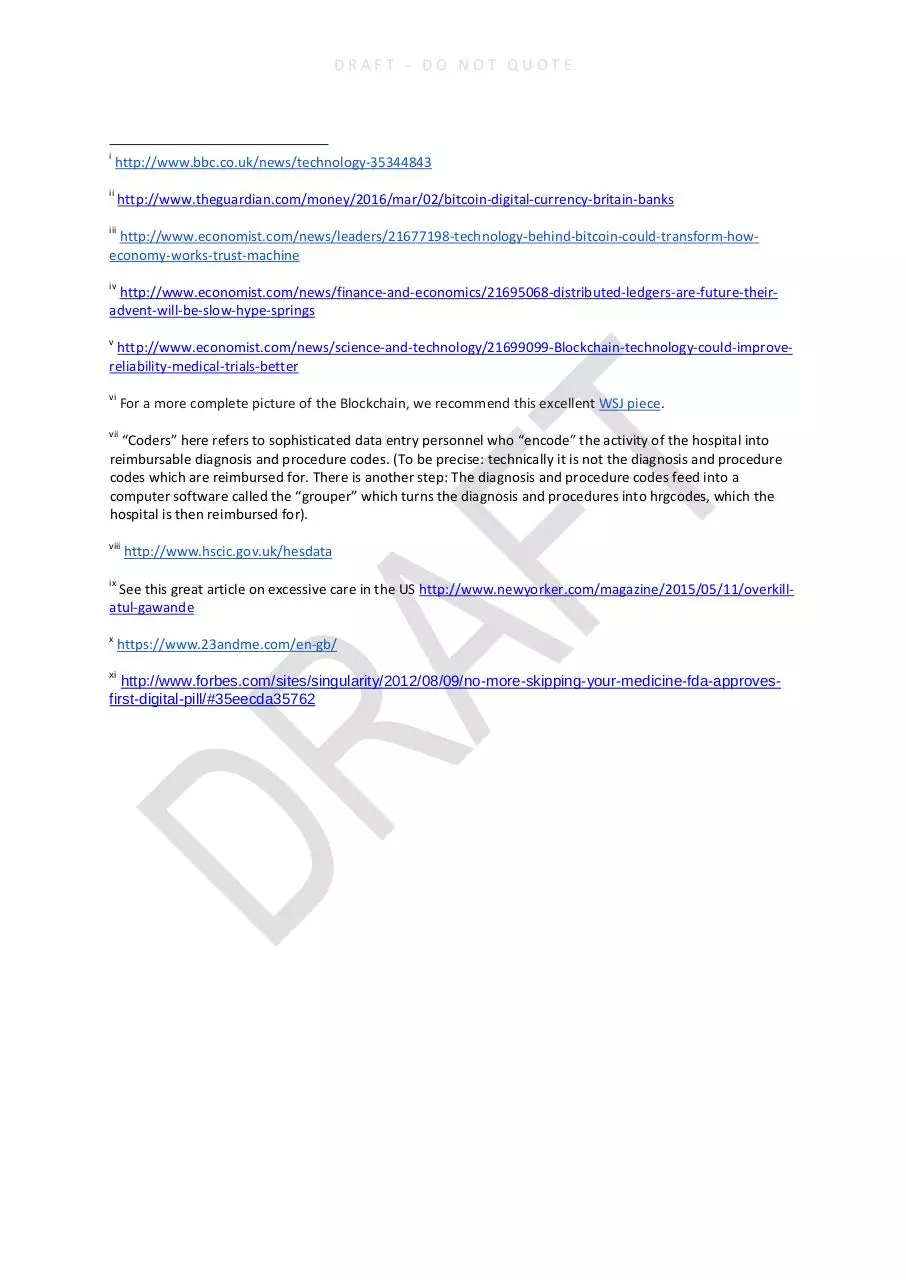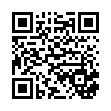Blockchain for healthcare data (PDF)
File information
Author: Moroy, Christian
This PDF 1.5 document has been generated by Acrobat PDFMaker 11 for Word / Adobe PDF Library 11.0, and has been sent on pdf-archive.com on 07/07/2016 at 18:23, from IP address 168.168.x.x.
The current document download page has been viewed 723 times.
File size: 300.23 KB (5 pages).
Privacy: public file





File preview
DRAFT - DO NOT QUOTE
Blockchains in
Healthcare:
Fundamentally,
it
infrastructure with
characteristics vi:
It is a distributed database: all data
on Blockchains is both administered
by the network and distributed
among the computers participating in
the network. This means that rather
than having a centralised actor
running and controlling the database
(and ensuring it does not get
compromised and leaks everyone’s
data!), all participants in the network
can use peer-to-peer communications
to read and write on the Blockchain.
This paradigm can provide cost,
performance
and
security
improvements
over
traditional
databases.
●
It is an identity and permission
management platform: each user in
the network holds the cryptographic
keys to decrypt their data on the
Blockchain, and may easily give
permission to other users’ (or
applications) keys to be able to access
their data. Having no central “single
point of failure” which holds all data
or all keys makes Blockchains more
resilient to breaches.
●
It is programmable (and open
source): although this isn’t a
characteristic of original bitcoin
Blockchain, Blockchains can be made
to store not only data, but also
computer programs (called smart
contracts). These programs can be
triggered by other activities on the
Blockchain, and are run in a
completely decentralised way by all
actors in the network. This can lead to
big cost and resilience gains.
Ernest Oppetit &
Christian Moroy
Intro
So what is it about Blockchain technology that
makes it so disruptive, and how could it be
applied to medical data and processes?
What is a Blockchain?
Just like the internet, Blockchain technology
has many different layers and functions, and
means different things to different people.
Having first emerged as the underlying
innovation powering Bitcoin, Blockchain
technology is now growing up to power
applications across all industries.
a
computing
following key
●
Perspectives for
the UK
Blockchains are a trending topic of discussion
these days. The Chief Scientific Advisor to the
UK government Sir Mark Walport argues they
can be used to make government
departments more secure i, the Bank of
England Deputy Governor Ben Broadbent
believes they can transform the way the bank
conducts its activities ii and The Economist
claims it will transform the way the economy
works iii, the way finance will operate iv,
and the way randomised controlled trials are
verifiedv.
is
the
DRAFT - DO NOT QUOTE
Current NHS data conundrums
Healthcare data impact
The current healthcare data storage,
collection, verification and retrieval processes
in the UK are far from streamlined. Let’s take
a look at the journey a typical patient’s data:
the patient turns up at a provider (a hospital
for example), activity is written up (on paper
most of the time) by the doctor, who then
ships the notes to coders vii to input the data
manually on their computer The resulting
datasets are stored on the hospital patient
administration (PAS) system and submitted to
SUS (secondary user system). The SUS data is
then sent to the Health and social care
information centre (HSCIC) who use it to
generate Hospital Episode Statistics (HES) viii
data which is distributed by them and used by
commissioners, providers or academics to
write strategic reports, identify gaps in
provision, benchmark design public policy or
answer various research questions. All of
these users have to undergo a lengthy
application process before receiving a cut of
the HES data.
There are three ways a Blockchain future
could improve the healthcare data landscape:
A similar data journey happens throughout
practices - primary care, mental health,
pharmacy, dentistry, social care etc. - but
each practice uses different systems which do
not talk to each other. Additionally, this
process does not cater for useful datasets
produced outside this ecosystem: privately
collected patient data coming from their
smartphones and wearable devices, data from
medical trials stored on academics computers,
government research datasets, etc. This leads
to data that is incomplete, inoperable, and
stored in disparate places. This in turn leads
to less effective decision making, too little or
too much care ix, and poorer health outcomes
for patients.
1) Consistency and interoperability: Using a
shared Blockchain to store all medical
data coming from each system, practice,
and device can help ensure no two
systems (across SUS, CCG, Trust etc.) have
a different view of the patient record. This
also ensures that data can be linked
across different parts of the patient
pathway - a critical hurdle for integrated
care.
2) Cost Savings & Easier Data Sharing:
Hospitals, Commissioners or Gvt. Agencies
could save millions of pounds a year spent
on Oracle or SAP systems by moving to
potentially free & open source Blockchain
tools, which leverage the network instead
of requiring dedicated storage and
computation power. With these tools,
access can be easily granted (with patient
consent) to any doctor, researcher,
analytics system, or app needing to
interact with the patient record. On top of
this, simplifying the data sharing process
lowers the barriers to entry for the next
wave of analytics applications.
3) Security & Empowerment: Currently
patient data is often inaccessible to the
patient themselves and stored in
centralised systems that may be
compromised by a one-off breach. As new
data such as genetic, sensor data, or
fitness activity enter the picture, this
becomes increasingly relevant. Giving the
patient access to her own data and a key
that allows them to decide who else
should be able to access it for research or
other purposes will increase security and
empower the patient.
DRAFT - DO NOT QUOTE
allocation optimisation. If a significant
sample of patients opt in, these actors
can have a better view of the market
demand for certain types of care (by
season, geography, patient genetic
makeup, socio-economic status etc)
and can better match supply.
Health Blockchains in practice
In order to gain some understanding of how
Blockchains can be used in the healthcare
realm let us create an extreme scenario that
paints a picture of a medical data world
entirely government by Blockchains:
Imagine Patient A - let's call her Lisa - who
holds her and her family’s historical medical
record, produces live fitness activity and
sensory data from wearable devices, and has
her DNA sequenced by 23andme. x What
would her place be in a Blockchain enabled
medical data world?
In a Blockchain-enabled world Lisa can:
●
●
Grant read and write access to her
data to Care Providers and Third
Party Applications, who can provide
superior and more cost-effective
health outcomes by having fast access
to the relevant data sets. For example
her dosage reminders could be
encoded into Smart Contracts
(resulting in a simple push notification
on her phone) and predictive
diagnostics applications could alert
her of issues before it’s too late
Have her data anonymously audited
by Government or Commissioners for
compliance, regulatory, and resource
●
Contribute to Medical Research by
providing her anonymised records,
and in turn benefitting from the latest
trials data and outcomes from leading
Medical Journals
●
Choose for her close family and/or
friends to be able to administer her
medical record and help her take
health decisions. For instance she may
choose to let her family see her
adherence to medication (potentially
captured through a Proteus “Smart
Pill”) xi and get alerts if she has missed
her medication
This theoretical world enables all authorised
participants to have a shared view of Lisa’s
data and the tools to securely interact with
her medical record.
Figure 1 on the next page shows how the
Blockchain can help achieve this and how it
might look like in its most developed form.
DRAFT - DO NOT QUOTE
Figure 1:
The healthcare Blockchain - a look into the future?
Source: Own illustration
Conclusion
Digitized medical data can play an important
part in improving health outcomes and
reducing the cost of care, but today’s
infrastructure and processes leave us barely
scratching the surface in terms of putting this
data to use. They are expensive, inoperable
between providers, don’t give patients access
to services, often inconsistent and while
extremely secure by today's standards don’t
have the highest possible level of security as
they are still subject to failure at discrete
points. To effectively benefit from digitized
medical records several challenges need to be
solved. These include secure and consistent
data sharing between systems,
access and control for patients as well as scale
and cost efficiency. These are complex
problems that require subtle approaches. In
this view Blockchain technology allows us to
look at these no longer as technical
impossibilities but as operational challenges.
This is already a significant step forward. At
least it is now technically possible to solve
some of these issues so even if Lisa’s world
might still be a far way away - conceptualising
it in the way we tried to do above will help us
think about new ways of tackling these issues.
Other countries have already recognised this
and are leading the way. For example as part
of its e-government system, the Estonian
government have rolled out a Blockchain
which is integrated into existing systems and
already secures 1 million health records. This
is exciting and points to a future in which data
security,
patient
empowerment
and
healthcare analytics play a more prominent
role in public life. Definitely worth paying
attention to!
DRAFT - DO NOT QUOTE
i
http://www.bbc.co.uk/news/technology-35344843
ii
http://www.theguardian.com/money/2016/mar/02/bitcoin-digital-currency-britain-banks
iii
http://www.economist.com/news/leaders/21677198-technology-behind-bitcoin-could-transform-howeconomy-works-trust-machine
iv
http://www.economist.com/news/finance-and-economics/21695068-distributed-ledgers-are-future-theiradvent-will-be-slow-hype-springs
v
http://www.economist.com/news/science-and-technology/21699099-Blockchain-technology-could-improvereliability-medical-trials-better
vi
For a more complete picture of the Blockchain, we recommend this excellent WSJ piece.
vii
“Coders” here refers to sophisticated data entry personnel who “encode” the activity of the hospital into
reimbursable diagnosis and procedure codes. (To be precise: technically it is not the diagnosis and procedure
codes which are reimbursed for. There is another step: The diagnosis and procedure codes feed into a
computer software called the “grouper” which turns the diagnosis and procedures into hrgcodes, which the
hospital is then reimbursed for).
viii
http://www.hscic.gov.uk/hesdata
ix
See this great article on excessive care in the US http://www.newyorker.com/magazine/2015/05/11/overkillatul-gawande
x
xi
https://www.23andme.com/en-gb/
http://www.forbes.com/sites/singularity/2012/08/09/no-more-skipping-your-medicine-fda-approvesfirst-digital-pill/#35eecda35762
Download Blockchain for healthcare data
Blockchain for healthcare data.pdf (PDF, 300.23 KB)
Download PDF
Share this file on social networks
Link to this page
Permanent link
Use the permanent link to the download page to share your document on Facebook, Twitter, LinkedIn, or directly with a contact by e-Mail, Messenger, Whatsapp, Line..
Short link
Use the short link to share your document on Twitter or by text message (SMS)
HTML Code
Copy the following HTML code to share your document on a Website or Blog
QR Code to this page

This file has been shared publicly by a user of PDF Archive.
Document ID: 0000398386.